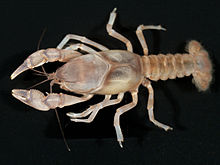진핵생물번역개시인자3 서브유닛D (eIF3d)는 [5] [6] EIF3D 유전자에 의해 인체 내에서 암호화되는 단백질 이다.
기능. eIF 중 가장 큰 진핵생물 번역 개시 인자 3(eIF3)은 적어도 10개의 동일하지 않은 서브유닛으로 이루어진 다단백질 복합체이다.복합체는 40S 리보솜 에 결합하고 40S 및 60S 리보솜 서브유닛을 해리 상태로 유지하도록 돕는다. 또한 eIF2/GTP/메티오닐-tRNA의 삼원복합체 와 상호작용하여 mRNA 결합을 촉진함으로써 40S 개시복합체 형성에 관여하는 것으로 생각된다. 이 유전자에 의해 암호화된 단백질은 eIF3 [6]
상호 작용 EIF3D는 PLDA1 [7] [8] [9] [10] EIF3A 와 상호작용하는 것으로 나타났다 .
EIF3D는 또한 비표준 메커니즘을 통해 c-Jun mRNA와 상호작용하는 것으로 나타났다. EIF4G 단백질이 번역을 매개하는 캡결합단백질로서 작용하는 대신 EIF3D는 EIF4G의 5' UTR 억제결합에서 구조를 가지며 EIF3D의 [11] 캡 결합 단백질로서의 EIF3D는 포도당 결핍과 같은 세포 스트레스 하에서 유전자 발현을 조절하는 데 중요한 것으로 여겨져 왔다. 포도당 결핍 조건 하 에서 c-Jun의 번역에서는 EIF3D의 캡 결합 활성이 10배 [12] [13]
「 」를 참조해 주세요. 레퍼런스 ^ a b c GRCh38: 앙상블 릴리즈 89: ENSG00000100353 - 앙상블 , 2017년 5월^ a b c GRCm38: 앙상블 릴리즈 89: ENSMUSG000016554 - 앙상블 , 2017년 5월^ "Human PubMed Reference:" . National Center for Biotechnology Information, U.S. National Library of Medicine .^ "Mouse PubMed Reference:" . National Center for Biotechnology Information, U.S. National Library of Medicine .^ Asano K, Vornlocher HP, Richter-Cook NJ, Merrick WC, Hinnebusch AG, Hershey JW (October 1997). "Structure of cDNAs encoding human eukaryotic initiation factor 3 subunits. Possible roles in RNA binding and macromolecular assembly" . The Journal of Biological Chemistry . 272 (43): 27042–27052. doi :10.1074/jbc.272.43.27042 PMID 9341143 . ^ a b "Entrez Gene: EIF3S7 eukaryotic translation initiation factor 3, subunit 7 zeta, 66/67kDa" .^ Hinz T, Flindt S, Marx A, Janssen O, Kabelitz D (May 2001). "Inhibition of protein synthesis by the T cell receptor-inducible human TDAG51 gene product". Cellular Signalling . 13 (5): 345–352. doi :10.1016/S0898-6568(01)00141-3 . PMID 11369516 . ^ Ewing RM, Chu P, Elisma F, Li H, Taylor P, Climie S, et al. (2007). "Large-scale mapping of human protein-protein interactions by mass spectrometry" . Molecular Systems Biology . 3 (1): 89. doi :10.1038/msb4100134 . PMC 1847948 PMID 17353931 . ^ Mayeur GL, Fraser CS, Peiretti F, Block KL, Hershey JW (October 2003). "Characterization of eIF3k: a newly discovered subunit of mammalian translation initiation factor elF3" . European Journal of Biochemistry . 270 (20): 4133–4139. doi :10.1046/j.1432-1033.2003.03807.x PMID 14519125 . ^ Block KL, Vornlocher HP, Hershey JW (November 1998). "Characterization of cDNAs encoding the p44 and p35 subunits of human translation initiation factor eIF3" . The Journal of Biological Chemistry . 273 (48): 31901–31908. doi :10.1074/jbc.273.48.31901 PMID 9822659 . ^ Lee AS, Kranzusch PJ, Doudna JA, Cate JH (August 2016). "eIF3d is an mRNA cap-binding protein that is required for specialized translation initiation" . Nature . 536 (7614): 96–99. doi :10.1038/nature18954 . PMC 5003174 PMID 27462815 . ^ Jia L, Qian SB (January 2021). "A Versatile eIF3d in Translational Control of Stress Adaptation". Molecular Cell . 81 (1): 10–12. doi :10.1016/j.molcel.2020.12.016 . PMID 33417853 . ^ Lamper AM, Fleming RH, Ladd KM, Lee AS (November 2020). "A phosphorylation-regulated eIF3d translation switch mediates cellular adaptation to metabolic stress". Science . 370 (6518): 853–856. doi :10.1126/science.abb0993 . PMID 33184215 .
추가 정보 Asano K, Kinzy TG, Merrick WC, Hershey JW (January 1997). "Conservation and diversity of eukaryotic translation initiation factor eIF3" . The Journal of Biological Chemistry . 272 (2): 1101–1109. doi :10.1074/jbc.272.2.1101 PMID 8995409 . Méthot N, Rom E, Olsen H, Sonenberg N (January 1997). "The human homologue of the yeast Prt1 protein is an integral part of the eukaryotic initiation factor 3 complex and interacts with p170" . The Journal of Biological Chemistry . 272 (2): 1110–1116. doi :10.1074/jbc.272.2.1110 PMID 8995410 . Block KL, Vornlocher HP, Hershey JW (November 1998). "Characterization of cDNAs encoding the p44 and p35 subunits of human translation initiation factor eIF3" . The Journal of Biological Chemistry . 273 (48): 31901–31908. doi :10.1074/jbc.273.48.31901 PMID 9822659 . Dunham I, Shimizu N, Roe BA, Chissoe S, Hunt AR, Collins JE, et al. (December 1999). "The DNA sequence of human chromosome 22" . Nature . 402 (6761): 489–495. doi :10.1038/990031 PMID 10591208 . Asano K, Shalev A, Phan L, Nielsen K, Clayton J, Valásek L, et al. (May 2001). "Multiple roles for the C-terminal domain of eIF5 in translation initiation complex assembly and GTPase activation" . The EMBO Journal . 20 (9): 2326–2337. doi :10.1093/emboj/20.9.2326 . PMC 125443 PMID 11331597 . Hinz T, Flindt S, Marx A, Janssen O, Kabelitz D (May 2001). "Inhibition of protein synthesis by the T cell receptor-inducible human TDAG51 gene product". Cellular Signalling . 13 (5): 345–352. doi :10.1016/S0898-6568(01)00141-3 . PMID 11369516 . Morris-Desbois C, Réty S, Ferro M, Garin J, Jalinot P (December 2001). "The human protein HSPC021 interacts with Int-6 and is associated with eukaryotic translation initiation factor 3" . The Journal of Biological Chemistry . 276 (49): 45988–45995. doi :10.1074/jbc.M104966200 PMID 11590142 . Mayeur GL, Fraser CS, Peiretti F, Block KL, Hershey JW (October 2003). "Characterization of eIF3k: a newly discovered subunit of mammalian translation initiation factor elF3" . European Journal of Biochemistry . 270 (20): 4133–4139. doi :10.1046/j.1432-1033.2003.03807.x PMID 14519125 . Collins JE, Wright CL, Edwards CA, Davis MP, Grinham JA, Cole CG, et al. (2004). "A genome annotation-driven approach to cloning the human ORFeome" . Genome Biology . 5 (10): R84. doi :10.1186/gb-2004-5-10-r84 . PMC 545604 PMID 15461802 . Rush J, Moritz A, Lee KA, Guo A, Goss VL, Spek EJ, et al. (January 2005). "Immunoaffinity profiling of tyrosine phosphorylation in cancer cells". Nature Biotechnology . 23 (1): 94–101. doi :10.1038/nbt1046 . PMID 15592455 . Ewing RM, Chu P, Elisma F, Li H, Taylor P, Climie S, et al. (2007). "Large-scale mapping of human protein-protein interactions by mass spectrometry" . Molecular Systems Biology . 3 (1): 89. doi :10.1038/msb4100134 . PMC 1847948 PMID 17353931 .







